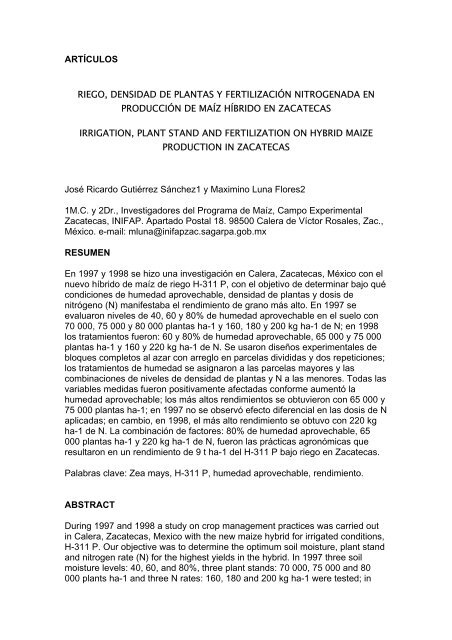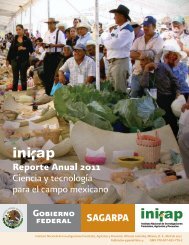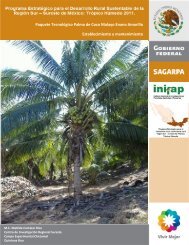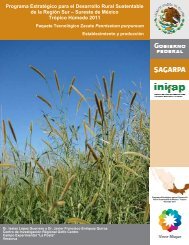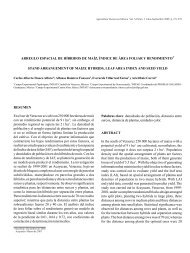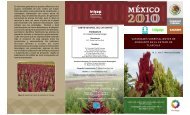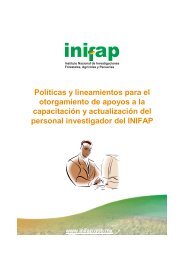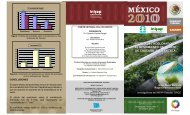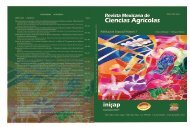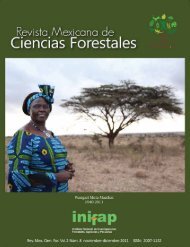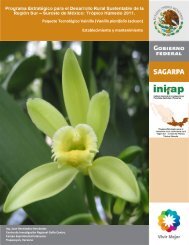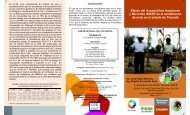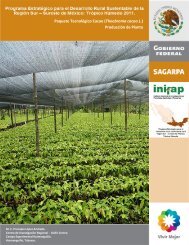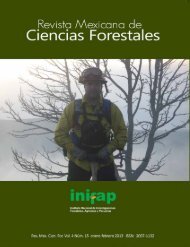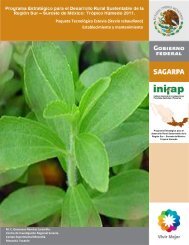artÃÂculos riego, densidad de plantas y fertilización nitrogenada
artÃÂculos riego, densidad de plantas y fertilización nitrogenada
artÃÂculos riego, densidad de plantas y fertilización nitrogenada
Create successful ePaper yourself
Turn your PDF publications into a flip-book with our unique Google optimized e-Paper software.
ARTÍCULOS<br />
RIEGO, DENSIDAD DE PLANTAS Y FERTILIZACIÓN NITROGENADA EN<br />
PRODUCCIÓN DE MAÍZ HÍBRIDO EN ZACATECAS<br />
IRRIGATION, PLANT STAND AND FERTILIZATION ON HYBRID MAIZE<br />
PRODUCTION IN ZACATECAS<br />
José Ricardo Gutiérrez Sánchez1 y Maximino Luna Flores2<br />
1M.C. y 2Dr., Investigadores <strong>de</strong>l Programa <strong>de</strong> Maíz, Campo Experimental<br />
Zacatecas, INIFAP. Apartado Postal 18. 98500 Calera <strong>de</strong> Víctor Rosales, Zac.,<br />
México. e-mail: mluna@inifapzac.sagarpa.gob.mx<br />
RESUMEN<br />
En 1997 y 1998 se hizo una investigación en Calera, Zacatecas, México con el<br />
nuevo híbrido <strong>de</strong> maíz <strong>de</strong> <strong>riego</strong> H-311 P, con el objetivo <strong>de</strong> <strong>de</strong>terminar bajo qué<br />
condiciones <strong>de</strong> humedad aprovechable, <strong><strong>de</strong>nsidad</strong> <strong>de</strong> <strong>plantas</strong> y dosis <strong>de</strong><br />
nitrógeno (N) manifestaba el rendimiento <strong>de</strong> grano más alto. En 1997 se<br />
evaluaron niveles <strong>de</strong> 40, 60 y 80% <strong>de</strong> humedad aprovechable en el suelo con<br />
70 000, 75 000 y 80 000 <strong>plantas</strong> ha-1 y 160, 180 y 200 kg ha-1 <strong>de</strong> N; en 1998<br />
los tratamientos fueron: 60 y 80% <strong>de</strong> humedad aprovechable, 65 000 y 75 000<br />
<strong>plantas</strong> ha-1 y 160 y 220 kg ha-1 <strong>de</strong> N. Se usaron diseños experimentales <strong>de</strong><br />
bloques completos al azar con arreglo en parcelas divididas y dos repeticiones;<br />
los tratamientos <strong>de</strong> humedad se asignaron a las parcelas mayores y las<br />
combinaciones <strong>de</strong> niveles <strong>de</strong> <strong><strong>de</strong>nsidad</strong> <strong>de</strong> <strong>plantas</strong> y N a las menores. Todas las<br />
variables medidas fueron positivamente afectadas conforme aumentó la<br />
humedad aprovechable; los más altos rendimientos se obtuvieron con 65 000 y<br />
75 000 <strong>plantas</strong> ha-1; en 1997 no se observó efecto diferencial en las dosis <strong>de</strong> N<br />
aplicadas; en cambio, en 1998, el más alto rendimiento se obtuvo con 220 kg<br />
ha-1 <strong>de</strong> N. La combinación <strong>de</strong> factores: 80% <strong>de</strong> humedad aprovechable, 65<br />
000 <strong>plantas</strong> ha-1 y 220 kg ha-1 <strong>de</strong> N, fueron las prácticas agronómicas que<br />
resultaron en un rendimiento <strong>de</strong> 9 t ha-1 <strong>de</strong>l H-311 P bajo <strong>riego</strong> en Zacatecas.<br />
Palabras clave: Zea mays, H-311 P, humedad aprovechable, rendimiento.<br />
ABSTRACT<br />
During 1997 and 1998 a study on crop management practices was carried out<br />
in Calera, Zacatecas, Mexico with the new maize hybrid for irrigated conditions,<br />
H-311 P. Our objective was to <strong>de</strong>termine the optimum soil moisture, plant stand<br />
and nitrogen rate (N) for the highest yields in the hybrid. In 1997 three soil<br />
moisture levels: 40, 60, and 80%, three plant stands: 70 000, 75 000 and 80<br />
000 plants ha-1 and three N rates: 160, 180 and 200 kg ha-1 were tested; in
1998 the treatments were: 60 and 80 % available soil moisture, 65 000 and 75<br />
000 plants ha-1 and 160 and 220 kg ha-1 N. In both years a random complete<br />
block <strong>de</strong>sign with a split plot arrangement was utilized. Soil moisture treatments<br />
were assigned to large plots and combinations of plant stands and N rates to<br />
the small plots. The effect of increasing soil moisture was positive on all<br />
recor<strong>de</strong>d traits and the higher yields were obtained with 65 000 and 75 000<br />
plants ha –1. In 1997 no differences were observed among N rates, whereas in<br />
1998, 220 kg ha -1 of N produced the highest yield. The combination of 80%<br />
soil moisture, 65 000 plants ha -1 and 220 kg ha -1 of N resulted in a yield of 9 t<br />
ha-1 with the H-311 P maize hybrid un<strong>de</strong>r irrigated conditions in Zacatecas.<br />
Key words: Zea mays, hybrid H-311 P, available soil moisture, yield.<br />
DINÁMICA POBLACIONAL DE MALEZAS EN DIFERENTES SISTEMAS DE<br />
LABRANZA Y MÉTODOS DE CONTROL EN LA ROTACIÓN TRIGO-MAÍZ<br />
WEED POPULATION DYNAMICS IN A WHEAT-MAIZE ROTATION UNDER<br />
DIFFERENT TILLAGE SYSTEMS AND CONTROL METHODS<br />
Fernando Urzúa Soria1, Josué Kohashi Shibata2, Benjamín Figueroa<br />
Sandoval3 y Ángel Martínez Garza4.<br />
1M.C. 2Dr. Parte <strong>de</strong>l trabajo presentado por el primer autor para obtener el<br />
grado <strong>de</strong> Doctor en Ciencias. Especialidad <strong>de</strong> Botánica, 3Dr. Especialidad <strong>de</strong><br />
Edafología, Instituto <strong>de</strong> Recursos Naturales, 4Dr. Especialidad <strong>de</strong> Estadística.<br />
Colegio <strong>de</strong> Postgraduados, 56230 Montecillo, Edo. <strong>de</strong> Méx. México. Fax 595 95<br />
220-47. e-mail: urzua@taurus1.chapingo.mx.<br />
RESUMEN<br />
La investigación se llevó a cabo en el Campo Experimental <strong>de</strong> la Universidad<br />
Autónoma Chapingo, Chapingo, Edo. <strong>de</strong> Méx., <strong>de</strong> 1994 a 1997 en ocho ciclos<br />
agrícolas. Se evaluaron cuatro sistemas <strong>de</strong> labranza: 1) tradicional o<br />
convencional, 2) mínima, 3) cero y 4) siembra directa, en combinación con<br />
métodos <strong>de</strong> control <strong>de</strong> malezas (manual, químico y sin control) sobre la<br />
dinámica poblacional <strong>de</strong> las especies más importantes en la localidad <strong>de</strong><br />
prueba. Se cuantificó la <strong><strong>de</strong>nsidad</strong> y cobertura <strong>de</strong> las malezas a los 25 y 115<br />
días <strong>de</strong>spués <strong>de</strong> la emergencia <strong>de</strong> los cultivos y al final <strong>de</strong> cada ciclo se estimó<br />
su rendimiento. En el último año <strong>de</strong>l estudio se <strong>de</strong>terminaron algunas<br />
propieda<strong>de</strong>s físicas <strong>de</strong>l suelo para ver el efecto <strong>de</strong> los diferentes sistemas <strong>de</strong><br />
labranza. Durante el estudio se registraron 48 especies <strong>de</strong> malezas: 31<br />
ocurrieron en trigo, 45 en maíz y 28 en ambos cultivos. Las poblaciones <strong>de</strong><br />
Simsia amplexicaulis, Amaranthus hybridus y Chenopodium album se<br />
incrementaron con los tratamientos <strong>de</strong> labranza tradicional o convencional y<br />
mínima; en tanto que las <strong>de</strong> trigo espontáneo (actuando como maleza) Triticum<br />
aestivum, Cynodon dactylon, Bromus catharticus, Reseda luteola y Rumex<br />
crispus, lo hicieron en los tratamientos <strong>de</strong> labranza cero y siembra directa.<br />
Brachiaria plantaginea, Cyperus esculentus, Oxalis latifolia, Malva parviflora,
Ipomoea purpurea y Sicyos <strong>de</strong>ppei no presentaron respuesta clara a los<br />
tratamientos evaluados. Las bajas temperaturas y las heladas disminuyeron las<br />
poblaciones <strong>de</strong> malezas en el cultivo <strong>de</strong> trigo. En los tratamientos <strong>de</strong> labranza<br />
cero y siembra directa los manchones <strong>de</strong> C. dactylon se incrementaron y<br />
redujeron el rendimiento <strong>de</strong>l trigo. Los residuos <strong>de</strong> cosecha sobre la superficie<br />
<strong>de</strong>l suelo en la siembra directa contribuyeron a conservar la humedad e<br />
incrementar el rendimiento <strong>de</strong>l maíz.<br />
Palabras clave: Siembra directa, <strong><strong>de</strong>nsidad</strong> y cobertura <strong>de</strong> malezas, residuos <strong>de</strong><br />
cosecha.<br />
ABSTRACT<br />
This research was conducted at the Experimental Station of the Autonomous<br />
University of Chapingo, Chapingo, State of Mexico, during four years (1994 to<br />
1997) or eight cropping cycles with wheat in winter and maize in summer. The<br />
effects of four tillage systems: 1) traditional or conventional, 2) minimal, 3) zero,<br />
and 4) direct planting, and three weed control methods (manual, chemical and<br />
no-control) on the population dynamics of the most important weed species in<br />
the test site were <strong>de</strong>termined. Weed <strong>de</strong>nsity and ground cover were registered<br />
at 25 and 115 days after planting. At the end of each cycle crop yields were<br />
measured. During the last year of the study, several soil physical characteristics<br />
were <strong>de</strong>termined to know the effects of each of the four tillage systems. Forty<br />
eight weed species were registered: 31 occurred in wheat, 45 in maize and 28<br />
in both crops. The populations of Simsia amplexicaulis, Amaranthus hybridus<br />
and Chenopodium album increased un<strong>de</strong>r the conventional and minimal tillage,<br />
while those of volunteer Triticumaestivum (wheat acting as weed), Cynodon<br />
dactylo Bromus catharticus, Reseda luteola and Rumex crispus increased<br />
un<strong>de</strong>r zero tillage and direct planting. Brachiaria plantaginea, Cyperus<br />
esculentus, Oxalis latifolia, Malva parviflora, Ipomoea purpurea and Sicyos<br />
<strong>de</strong>ppei did not show a clear response pattern to the treatments tested. Low<br />
winter temperatures and frosts were responsible for the scarce weed<br />
populations during the wheat cycle. Spots of C. dactylon increased un<strong>de</strong>r zero<br />
tillage and direct planting, lowering wheat yield production. The crop residues<br />
left on the soil in direct planting contributed to maintain soil moisture and to<br />
increase maize yield.<br />
Key words: Direct planting, ground cover and <strong>de</strong>nsity, crop residues.<br />
CULTIVOS ALTERNATIVOS PARA EL ALTIPLANO SEMIÁRIDO DE MÉXICO<br />
ALTERNATIVE CROPS FOR THE SEMIARID HIGHLANDS OF MEXICO<br />
Roberto Ochoa Márquez1, Luis Reyes Muro2, Francisco Javier Robles<br />
Escobedo3 y J. Saúl Padilla Ramírez4<br />
1M.C. Programa <strong>de</strong> Frijol, rochoa@pabellon.inifap.conacyt.mx 2M.C. Programa<br />
<strong>de</strong> Socioeconomía, lreyes@pabellon.inifap.conacyt.mx 3Ing. Programa <strong>de</strong>
Difusión Técnica, frobles@pabellon.inifap.conacyt.mx y 4Dr. Programa <strong>de</strong><br />
Frijol, jpadilla@pabellon.inifap.conacyt.mx Investigadores <strong>de</strong>l Campo<br />
Experimental Pabellón, INIFAP. km 32.5 Carr. Aguascalientes – Zacatecas.<br />
20660 Pabellón <strong>de</strong> Arteaga, Ags., México<br />
RESUMEN<br />
En la región <strong>de</strong>l Altiplano Semiárido <strong>de</strong> México las lluvias tienen distribución<br />
errática y el rendimiento <strong>de</strong>l maíz y frijol es bajo. El temporal, según el inicio <strong>de</strong><br />
las lluvias en la región, se pue<strong>de</strong> clasificar en normal y tardío. Las siembras<br />
que se realizan en fechas tardías incrementan el riesgo por sequía y por bajas<br />
temperaturas durante el <strong>de</strong>sarrollo <strong>de</strong> los cultivos. El objetivo <strong>de</strong> la<br />
investigación fue evaluar diversos cultivos en temporal normal y tardío, con y<br />
sin <strong>riego</strong> <strong>de</strong> auxilio, para reducir los riesgos <strong>de</strong> producción en las áreas <strong>de</strong><br />
temporal <strong>de</strong>l Altiplano Semiárido <strong>de</strong> México. Los experimentos se establecieron<br />
en Sandovales y Montoya en el municipio <strong>de</strong> El Llano, Aguascalientes, México,<br />
en los ciclos 1999 y 2000. Se evaluaron tres factores: a) cultivos alternativos:<br />
cebada, avena, triticale, trigo, garbanzo y los testigos frijol y maíz; b) fechas <strong>de</strong><br />
siembra: temporal normal y temporal tardío y c) niveles <strong>de</strong> humedad: temporal<br />
solo y temporal más un <strong>riego</strong> <strong>de</strong> auxilio. En todos los cultivos se <strong>de</strong>terminó la<br />
producción <strong>de</strong> materia seca y grano. Las condiciones <strong>de</strong> humedad fueron más<br />
favorables en la época <strong>de</strong> siembra normal en ambos años y sitios, lo que se<br />
reflejó en mayor rendimiento <strong>de</strong> materia seca y grano; una respuesta similar<br />
ocurrió con el <strong>riego</strong> <strong>de</strong> auxilio en ambas fechas <strong>de</strong> siembra. Los cultivos<br />
alternativos al frijol y maíz mostraron tolerancia a las heladas. El maíz para<br />
forraje es una opción para temporal normal con y sin <strong>riego</strong> <strong>de</strong> auxilio y también<br />
para temporal tardío, aunque pue<strong>de</strong> sustituirse por avena o triticale. Los<br />
cultivos <strong>de</strong> ciclo largo como el maíz y el garbanzo mostraron alto riesgo para<br />
producir grano en siembras tardías; el frijol y la avena mostraron buena<br />
respuesta en siembras normales con y sin <strong>riego</strong> suplementario.<br />
Palabras clave: Temporal normal y tardío, <strong>riego</strong> suplementario, fechas <strong>de</strong><br />
siembra, producción <strong>de</strong> grano y materia seca, maíz, frijol.<br />
ABSTRACT<br />
In the semiarid highlands of Mexico, rainfall has an erratic distribution and<br />
therefore, maize and bean yields are low. In this region the rainfall season may<br />
be classified as “normal” or “<strong>de</strong>layed”, according to the onset of the rainy<br />
season. Whenever sowing time has to be <strong>de</strong>layed due to the late onset of rains,<br />
the risk of drought and crop damage by low temperatures increases. The<br />
objective of this research was to evaluate and promote possible alternative<br />
crops un<strong>de</strong>r normal and late rainfall, with and without supplemental irrigation to<br />
reduce production risks in rainfed areas. The experiment was established in two<br />
locations, Sandovales and Montoya in the county of El Llano, Aguascalientes,<br />
during 1999 and 2000. Three factors were evaluated: a) alternative crops:<br />
barley, oat, triticale, wheat, and chickpea with dry beans and maize as controls;<br />
b) sowing dates: normal and <strong>de</strong>layed; and c) soil moisture regimes: rainfall with<br />
and without supplemental irrigation. In both years the onset of rains was normal.<br />
Dry matter and grain yield were recor<strong>de</strong>d. Results indicated that soil moisture
conditions were more favorable in the first sowing date in both years and sites,<br />
which was reflected in higher dry matter and grain yield; a similar response was<br />
observed with supplemental irrigation in both planting dates. The alternative<br />
crops showed tolerance to low temperatures. Maize for forage production is a<br />
good option un<strong>de</strong>r normal planting with or without supplemental irrigation, and<br />
although it is still a good option un<strong>de</strong>r <strong>de</strong>layed planting, oat or triticale can also<br />
be good alternatives. Crops having a long growth cycle such as maize and<br />
chickpeas have a higher risk for grain production un<strong>de</strong>r <strong>de</strong>layed planting dates.<br />
Dry beans and oat for grain production showed good response un<strong>de</strong>r normal<br />
planting with or without supplemental irrigation.<br />
Key words: Rainfall, supplemental irrigation, sowing date, dry matter and grain<br />
yield, maize, dry bean.<br />
USO REDUCIDO DE INSECTICIDAS Y CONTROL BIOLÓGICO DE PLAGAS<br />
DEL JITOMATE EN OAXACA<br />
REDUCED INSECTICIDE USE AND BIOLOGICAL CONTROL OF TOMATO<br />
PESTS IN OAXACA<br />
Ernesto Bravo Mosqueda<br />
M.C., Investigador <strong>de</strong>l Programa <strong>de</strong> Entomología. Campo Experimental Valles<br />
Centrales <strong>de</strong> Oaxaca, INIFAP. Santo Domingo Barrio Bajo, Etla, Oaxaca,<br />
México. Apdo. Postal 33, Suc. B. 68000 Oaxaca, Oax. email:ebramosqueda@hotmail.com<br />
RESUMEN<br />
En esta investigación se evaluó el efecto <strong>de</strong> prácticas para la conservación <strong>de</strong><br />
organismos benéficos nativos en el cultivo <strong>de</strong>l jitomate, en las localida<strong>de</strong>s <strong>de</strong><br />
Tlacolula, Suchilquitongo y San Lorenzo Cacaotepec en los Valles Centrales <strong>de</strong><br />
Oaxaca, durante los años 1998 y 2000. Se establecieron experimentos bajo el<br />
diseño <strong>de</strong> parcelas apareadas con cinco repeticiones, en las cuales se<br />
realizaron conteos periódicos en <strong>plantas</strong> sometidas a dos tratamientos: 1) con<br />
aplicación completa <strong>de</strong> insecticidas y 2) aplicación reducida, en los que la<br />
población <strong>de</strong> organismos benéficos fue mayor (p>0.05) en el tratamiento con<br />
utilización reducida <strong>de</strong> insecticidas; en otra prueba experimental se evaluó la<br />
efectividad <strong>de</strong> tres atrayentes para insectos: miel <strong>de</strong> abeja, azúcar y Bio-Attrack<br />
(comercial), cuyos resultados indicaron que la aplicación <strong>de</strong> miel <strong>de</strong> abeja o<br />
azúcar incrementó en forma significativa la presencia <strong>de</strong> insectos benéficos<br />
como coccinéllidos y sírfidos, en particular cuando la población <strong>de</strong> pulgones fue<br />
baja en los lotes experimentales o en parcelas aledañas a éstas. La<br />
disminución <strong>de</strong> aplicaciones <strong>de</strong> insecticidas permitió el incremento <strong>de</strong> la<br />
<strong><strong>de</strong>nsidad</strong> poblacional <strong>de</strong> organismos benéficos, con la consecuente reducción<br />
en la población y en los daños ocasionados por las plagas en el cultivo <strong>de</strong><br />
jitomate.
Palabras clave: Lycopersicon esculentum,Mill., enemigos naturales,<br />
parasitoi<strong>de</strong>s, <strong>de</strong>predadores, mosca blanca, gusano <strong>de</strong>l fruto, virosis,<br />
atrayentes.<br />
ABSTRACT<br />
The effects of some cultural practices for the conservation of native beneficial<br />
organisms was evaluated in the tomato crop at three locations: Tlacolula,<br />
Suchilquitongo and San Lorenzo Cacaotepec in the Central Valleys of Oaxaca.<br />
Periodical insect counts were carried out on tomato plants grown un<strong>de</strong>r two<br />
treatments, 1) full (periodical) insectici<strong>de</strong> applications and 2) reduced chemical<br />
control. In a second trial, three insect attractants were evaluated: honey, sugar<br />
and Bio-Attrack (commercial). The population of the beneficial organisms was<br />
significantly higher in the experimental plots where pestici<strong>de</strong> applications were<br />
reduced. The application of attractants also significantly increased the presence<br />
of beneficial insects, mainly lady bug beetle (Coccinellidae) and syrphid flies,<br />
particularly when the aphid populations in the experimental plots or in neighbor<br />
fields were low. As a consequence of the increase in the population of beneficial<br />
organisms, the population of pests and their damage to the tomato crop were<br />
reduced.<br />
Key words: Lycopersicum esculentum, parasitoids, predators, whitefly, tomato<br />
fruitworm virus, attractants<br />
RENDIMIENTO DE HIBRIDOS DE CANOLA (Brassica napus L.)<br />
EN DIFERENTES MÉTODOS DE SIEMBRA<br />
YIELD OF CANOLA (Brassica napus L.) HYBRIDS<br />
IN DIFFERENT PLANTING SYSTEMS<br />
Alfredo S. Ortegón Morales,1 Arturo Díaz Franco1 y Alfredo Rodríguez<br />
Castillo2<br />
1MC. Investigadores <strong>de</strong>l Programa Nuevas Opciones. Campo Experimental Río<br />
Bravo, INIFAP. Apdo. Postal 172. 88900 Río Bravo, Tamaulipas, México. email:<br />
ortegona@cirne.inifap.conacyt.mx 2MC. Laboró en el INIFAP hasta<br />
diciembre <strong>de</strong> 1999.<br />
RESUMEN<br />
La canola es una oleaginosa con potencial para integrarse al sistema <strong>de</strong><br />
producción agrícola <strong>de</strong>l Norte <strong>de</strong> Tamaulipas. Para modificar el método <strong>de</strong><br />
siembra en plano con hileras a 0.35 m que se practica en los principales países<br />
productores <strong>de</strong> este grano, se realizó un estudio en el Ciclo Otoño-Invierno (O-<br />
I) 1999-2000 con los híbridos Hyola 330, Hyola 401 y Hyola 420, en Río Bravo,<br />
Tamaulipas, México, para evaluar los métodos <strong>de</strong> siembra: 1) en surcos a 0.80<br />
m con hilera sencilla, 2) en surcos a 0.80 m con doble hilera, separados a 0.20<br />
m y 3) en plano con hileras a 0.35 m. Con base en el rendimiento, los
esultados <strong>de</strong>mostraron que la siembra <strong>de</strong> canola en surcos sencillos tiene<br />
similar potencial a la siembra en doble hilera y en plano a 0.35 m. A<strong>de</strong>más, se<br />
estableció una parcela <strong>de</strong> validación en Reynosa, Tamaulipas, en el Ciclo O-I<br />
1998-1999, con los híbridos <strong>de</strong> canola Hyola 420 y Hyola 330, para verificar su<br />
rendimiento en siembras en surcos <strong>de</strong> 0.91 m <strong>de</strong> ancho en hilera sencilla. Se<br />
midieron características morfológicas <strong>de</strong> la planta para i<strong>de</strong>ntificar las<br />
relacionadas con el rendimiento <strong>de</strong> semilla; se practicó un análisis <strong>de</strong> sen<strong>de</strong>ro<br />
con la matriz <strong>de</strong> correlaciones para conocer con precisión el efecto <strong>de</strong> cada<br />
característica sobre el rendimiento y se <strong>de</strong>terminó la factibilidad <strong>de</strong> sembrar la<br />
canola en surcos sencillos. En la parcela <strong>de</strong> validación el diámetro <strong>de</strong>l tallo,<br />
número <strong>de</strong> silicuas, número <strong>de</strong> ramas y peso <strong>de</strong> materia seca por planta,<br />
fueron las características <strong>de</strong> mayor correlación con el peso <strong>de</strong> semilla por<br />
planta en ambos híbridos. Como efecto directo predominó el peso <strong>de</strong> materia<br />
seca sobre el peso <strong>de</strong> semilla por planta y como efecto indirecto mostró<br />
influencia sobre las <strong>de</strong>más características en relación con el peso <strong>de</strong> semilla. El<br />
método <strong>de</strong> siembra en surcos sencillos redujo en más <strong>de</strong> 60% la cantidad <strong>de</strong><br />
semilla para siembra comparado con las siembras en plano en hileras a 0.35<br />
m. Los resultados comerciales con rendimiento <strong>de</strong> 1600 kg ha-1 indican que la<br />
canola es un cultivo competitivo y viable para la región Norte <strong>de</strong> Tamaulipas.<br />
Palabras clave: Características <strong>de</strong> planta, producción comercial.<br />
ABSTRACT<br />
Canola is an oil crop with potential for being integrated into the agricultural<br />
production systems in the North of Tamaulipas, Mexico. With the aim of<br />
modifying the planting method flat rows at 0.35 m utilized in main producing<br />
countries a study was carried out to evaluate in three canola hybrids Hyola 330,<br />
Hyola 401 and Hyola 420 the following planting methods: 1) in rows at 0.80 m<br />
with a single plant line, 2) in rows at 0.80 m with double plants line spaced at<br />
0.20 m and 3) in flat rows spaced at 0.35 m. Based on yield, results indicated<br />
that canola hybrids grown in single rows have the same potential as in double<br />
rows or 0.35 m spaced rows. In the winter cicle of 1998-1999 a commercial plot<br />
was established in farmer’s fields to validate two canola hybrids, Hyola 420 and<br />
Hyola 330, planted in single 0.91 m rows. The most important morphological<br />
plant characteristics were correlated to seed yield using a correlation matrix a<br />
‘path-coefficient analysis’ was performed to <strong>de</strong>termine with higher precision the<br />
effect of each plant characteristic on seed yield. The number of plants per meter<br />
of row was negatively correlated to plant seed weight. Stem diameter, seed and<br />
pods per plant, and plant dry matter showed the highest correlation to plant<br />
seed yield in both hybrids. Plant dry matter, as a direct effect, has a<br />
predominant influence on seed weight per plant. Also, as an indirect effect,<br />
plant dry matter showed influence on the other plant characteristics evaluated in<br />
its relationship to seed yield. In comparison with planting in 0.35 m rows, wi<strong>de</strong><br />
spaced rows reduced in more than 60% the amount of seed nee<strong>de</strong>d per<br />
hectare. The results from commercial fields with an average yield of 1600 kg<br />
ha-1 indicated that canola can be a competitive crop in the North of Tamaulipas.<br />
Key words: Plant characteristics, commercial production.
ENSAYO<br />
CALIDAD ALIMENTARIA Y POTENCIAL NUTRACÉUTICO DEL FRIJOL<br />
(Phaseolus vulgaris L.) *<br />
FOOD QUALITY AND NUTRACEUTICAL POTENTIAL OF COMMON BEAN<br />
(Phaseolus vulgaris L.)<br />
Salvador Horacio Guzmán Maldonado1, Jorge Alberto Acosta Gallegos2, María<br />
<strong>de</strong> los Ángeles Álvarez-Muñoz3, Sonia García-Delgado3 y Guadalupe Loarca-<br />
Piña4<br />
1Dr. Laboratorio <strong>de</strong> Biotecnología, e-mail: sguzman76@hotmail.com 2 Dr.<br />
Programa <strong>de</strong> Leguminosas Comestibles, investigadores <strong>de</strong>l Campo<br />
Experimental Bajío, INIFAP. Km 6.5 carretera Celaya – San Miguel Allen<strong>de</strong>.<br />
Apdo. Postal 112, 38010 Celaya, Gto., México. 3 Q.A.y 4 Dra. Investigadoras<br />
<strong>de</strong>l Programa <strong>de</strong> Postgrado en Alimentos <strong>de</strong>l Centro <strong>de</strong> la República, Avenida<br />
Hidalgo s/n, Ciudad Universitaria, Escuela <strong>de</strong> Química, Universidad Autónoma<br />
<strong>de</strong> Querétaro, México.<br />
RESUMEN<br />
Los alimentos <strong>de</strong>rivados <strong>de</strong> las <strong>plantas</strong> a<strong>de</strong>más <strong>de</strong> los nutrimentos como son<br />
los carbohidratos, proteínas y grasas, entre otros, contienen compuestos<br />
conocidos como fitoquímicos que proveen beneficios adicionales a la salud<br />
humana, los cuales están presentes en alimentos como cereales, frutas y<br />
leguminosas. La evi<strong>de</strong>ncia científica continua acumulándose en apoyo al papel<br />
<strong>de</strong> los fitoquímicos en la prevención y tratamiento <strong>de</strong> enfermeda<strong>de</strong>s, como<br />
consecuencia <strong>de</strong>l número <strong>de</strong> componentes que tienen un efecto benéfico sobre<br />
la salud. El frijol común es una <strong>de</strong> las fuentes principales <strong>de</strong> proteína, calorías,<br />
vitaminas <strong>de</strong>l complejo B y minerales en la dieta <strong>de</strong>l pueblo mexicano. En las<br />
áreas rurales, 15% <strong>de</strong> su alimentación es frijol y 65% maíz . Se reconoce al<br />
frijol por su alto contenido <strong>de</strong> proteína y, más recientemente, por su contenido<br />
<strong>de</strong> fibra soluble. Últimamente se conduce investigación sobre las<br />
características nutracéuticas <strong>de</strong>l frijol. Otros componentes <strong>de</strong> este grano son<br />
los llamados factores antinutricionales, que incluyen los oligosacáridos, taninos,<br />
inhibidores <strong>de</strong> tripsina, lectinas y ácido fítico que se relacionan con la baja<br />
digestibilidad <strong>de</strong> la proteína y la reducción <strong>de</strong> la bio disponibilidad <strong>de</strong> los<br />
minerales, entre otros. A pesar <strong>de</strong> los efectos negativos <strong>de</strong> los factores<br />
antinutricionales, la evi<strong>de</strong>ncia científica está <strong>de</strong>mostrando su papel benéfico en<br />
la prevención y tratamiento <strong>de</strong> enfermeda<strong>de</strong>s crónico-<strong>de</strong>generativas. Con base<br />
en el contenido nutricional y los componentes fitoquímicos <strong>de</strong>l frijol común, los<br />
nutriólogos <strong>de</strong>ben estimular a las familias a consumir más frijol.<br />
Palabras clave: Fitoquímicos, factores antinutricionales, salud humana.<br />
ABSTRACT
In addition to the nutrients that are involved in normal metabolic activity, plant<br />
foods contain components that may provi<strong>de</strong> additional health benefits. These<br />
food components, generally referred to as phytochemicals or health-promoting<br />
elements, are present in a number of frequently consumed food, such as<br />
cereals, fruits and legumes. In recent years, the number of food components<br />
shown to have potential benefits for human health has grown tremendously.<br />
Scientific evi<strong>de</strong>nce is accumulating to support the role of phytochemicals and<br />
nutraceutical foods in the prevention and treatment of disease. On the other<br />
hand, the common bean is one of the most important sources of protein,<br />
calories, B-complex vitamins, and minerals in Mexico. In rural areas, 15% of<br />
consumed foods are beans, 65% are maize. Beans have long been recognized<br />
for their protein content and more recently have been noted for their solublefibre<br />
content, but in general there has been relatively little research and<br />
discussion about the nutraceutical attributes of beans. Other components of the<br />
common beans, the so called anti-nutritional factors which inclu<strong>de</strong><br />
oligosacchari<strong>de</strong>s, tannins, trypsin inhibitors, lectins, and phytic acid, have been<br />
related to poor protein digestibility and reduction of mineral bioavailability. In<br />
spite of the negative aspect of anti-nutritional factors, scientific evi<strong>de</strong>nce<br />
supports the role of common bean in the prevention and treatment of human<br />
diseases. Given the nutrient profile and phytochemical contribution of beans,<br />
nutritionists should make a concerted effort to encourage the Public to consume<br />
more common beans.<br />
Key words: Phytochemicals, antinutritional factors, human health<br />
DESCRIPCIÓN DE CULTIVARES<br />
NEGRO MEDELLÍN, NUEVA VARIEDAD DE FRIJOL (Phaseolus vulgaris L.)<br />
PARA LA REGIÓN TRÓPICO HÚMEDO DE MÉXICO *<br />
NEGRO MEDELLÍN, NEW BEAN (Phaseolus vulgaris L.) CULTIVAR FOR<br />
THE TROPICAL LOWLANDS OF MEXICO<br />
Ernesto López Salinas1 y Jorge A. Acosta Gallegos2<br />
1 M.C. Investigador <strong>de</strong>l Programa <strong>de</strong> Frijol <strong>de</strong>l Campo Experimental Cotaxtla.<br />
INIFAP. Apdo. Postal No. 429. Veracruz, Ver. e-mail: salinaser@hotmail.com. 2<br />
Dr. Lí<strong>de</strong>r Nacional <strong>de</strong> Investigación en Leguminosas Comestibles. Campo<br />
Experimental Bajío. INIFAP. Km 6.5 Carret. Celaya – San Miguel Allen<strong>de</strong>.<br />
Apdo. Postal 112. 38000 Celaya, Gto. e-mail: jamk@prodigy.net.mx<br />
H-153 MAÍZ HÍBRIDO PARA RIEGO EN LA ZONA DE TRANSICIÓN EL BAJÍO<br />
-VALLES ALTOS<br />
H-153 IRRIGATION MAIZE HYBRID FOR TRANSITION ZONE BAJIO - HIGH<br />
VALLEYS<br />
Alejandro Espinosa Cal<strong>de</strong>rón1, Margarita Ta<strong>de</strong>o Robledo2 , James Lothrop3 ,<br />
David Beck4 .
1 Dr. Investigador <strong>de</strong> Tecnología y Producción <strong>de</strong> Semillas, Campo<br />
Experimental Valle <strong>de</strong> México, INIFAP-SAGARPA. Km 18.5 Carretera Los<br />
Reyes-Lechería, Apartado Postal 10, C.P. 56230, Chapingo, México.<br />
espinoale@yahoo.com.mx. 2 M.C.Coordinadora <strong>de</strong> Cátedra <strong>de</strong> Semillas y<br />
Profesora <strong>de</strong> Asignatura, Ingeniería Agrícola, FESC-UNAM, Km. 2.5 Carretera<br />
México – Teoloyucán, Cuautitlán Izcalli, México. tarm@servidor.unam.com.mx.<br />
3 Dr. Mejorador <strong>de</strong> maíz, CIMMYT, El Batán, Edo. <strong>de</strong> México, hasta 1992. 4 Dr.<br />
Mejorador <strong>de</strong> Maíz, Valles Altos. CIMMYT, El Batán, Edo. <strong>de</strong> México.<br />
dbeckc@cgiar.org<br />
Regresar ...


